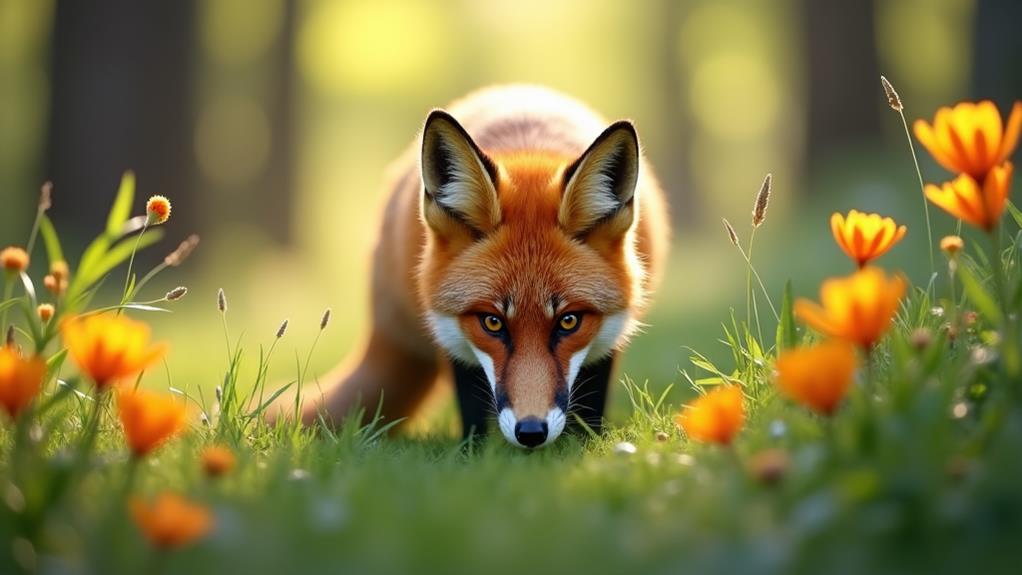Foxes have a super sniffer, thanks to their specially designed noses! Their larger nasal cavities and intricate structures, called turbinates, give them an edge in detecting scents. With a nose that's much bigger than ours, they can pick up smells from great distances, helping them track down prey and communicate with other foxes. These scent-savvy animals also rely on environmental factors like humidity and temperature to enhance their sniffing skills. So, while they might not be as good as dogs, foxes still pack a serious olfactory punch. Stick around, and you'll uncover more amazing facts about this clever critter!
Contents
Anatomy of the Fox Nose
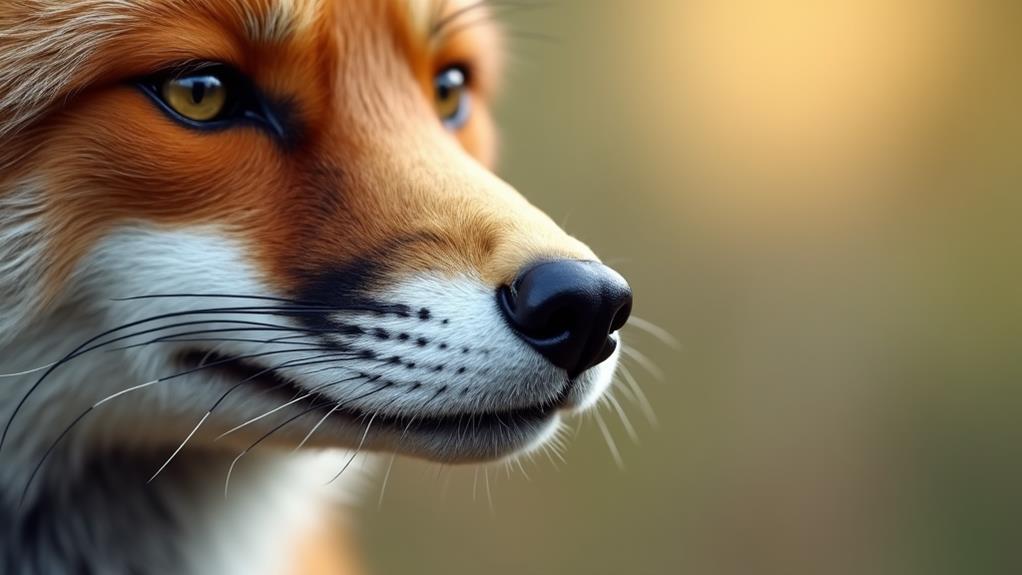
The anatomy of a fox nose is fascinatingly adapted for its environment. You see, a fox's sense of smell is off the charts! Their nasal cavity is larger relative to their body size compared to ours, giving them the ability to pick up scents we might completely miss.
Inside that clever nose, you'll find extensive nasal turbinates, which increase the surface area of the olfactory epithelium. This means they can detect odors at extremely low concentrations—pretty impressive, right?
But that's not all. The olfactory epithelium in foxes is estimated to be around 30-40 square centimeters, much larger than humans'! This gives them a superpower when it comes to finding food or communicating with others.
Their anatomy of a fox nose also includes specialized scent glands on their feet, face, and near the tail, which they use for marking territory.
Scent Detection Mechanisms
Exploring the intricate scent detection mechanisms of foxes reveals just how remarkable their olfactory abilities are. These clever creatures have a highly developed sense of smell that helps them thrive in the wild, playing a vital role in their hunting and social behaviors.
For instance, fox species, such as the Red Fox, utilize their keen sense of smell to locate prey and communicate with one another effectively. With specialized turbinates in their noses, their olfactory epithelium has a much larger surface area, allowing them to detect fox scent with impressive precision.
While we mightn't have all the shiny scientific data, anecdotal evidence hints that wild foxes boast a sense of smell on par with our beloved dogs and cats. This keen sense allows them to hunt for food, communicate with fellow foxes, and steer clear of predators. You can picture them sniffing out a tasty treat or even locating a buddy lost in the woods!
Their tail glands and anal sacs play a role too, enabling them to leave marks that other foxes can interpret.
However, despite all this sniffing prowess, observational studies suggest wild foxes still tend to trust their eyes more than their noses when it comes to hunting. It's a wild, wonderful mix of senses that keeps these furry friends one step ahead in nature's game!
Importance of Olfactory Communication
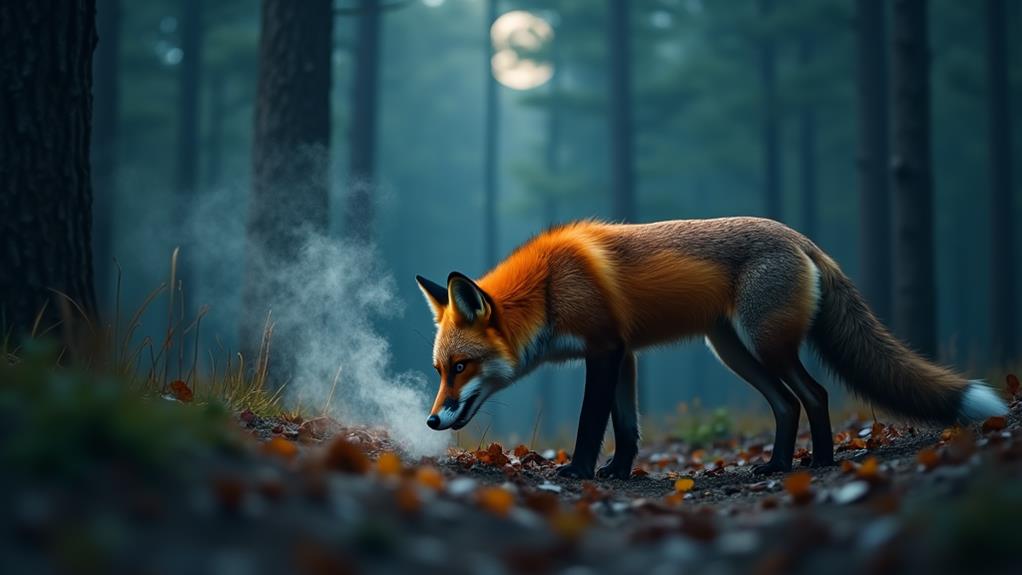
Foxes rely heavily on their remarkable sense of smell not just for hunting, but also for communicating with one another. Their acute olfactory abilities help them send and receive important messages through scent cues they leave behind.
Research shows that different fox species, such as the Red fox and Arctic fox, have developed unique adaptations to enhance their communication and survival. When a fox marks its territory with urine or feces, it's not just leaving a message; it's conducting a whole conversation. Each scent tells its own story, revealing everything from dietary health to social standings within their furry community.
The unique chemicals in fox urine, especially those sulfur-containing compounds, play a key role in this chemical communication. They help other foxes understand who's been around and what they might be up to.
Scent marking is essential for maintaining social hierarchies too—foxes can smell their neighbors and avoid unnecessary confrontations, which is always a good thing.
Comparing Smell With Other Animals
Understanding the complexities of smell reveals fascinating differences across the animal kingdom. Animal noses vary greatly, making each species unique. Here are some intriguing comparisons:
- Foxes have a complex nasal structure, helping them with smell but still less keen than dogs.
- Dogs boast about 70 sq-cm of olfactory surface area, making their noses super-sleuths by sniffing out scents we can't even imagine.
- Cats come in at about 21 sq-cm, showcasing how varied olfactory abilities can be among similar species.
- Humans? We're hanging out with just 5 sq-cm. Good luck in a scent competition!
While foxes have notable olfactory skills, they don't completely dominate the smell game. They rely on their sight more in some situations, showing a preference they mightn't share with other canids.
Fox numbers help control their environments, aiding in communication, finding food, and staying safe. However, they can struggle with certain scents, like locating buried treats, depending on proximity.
Role of Scent in Hunting
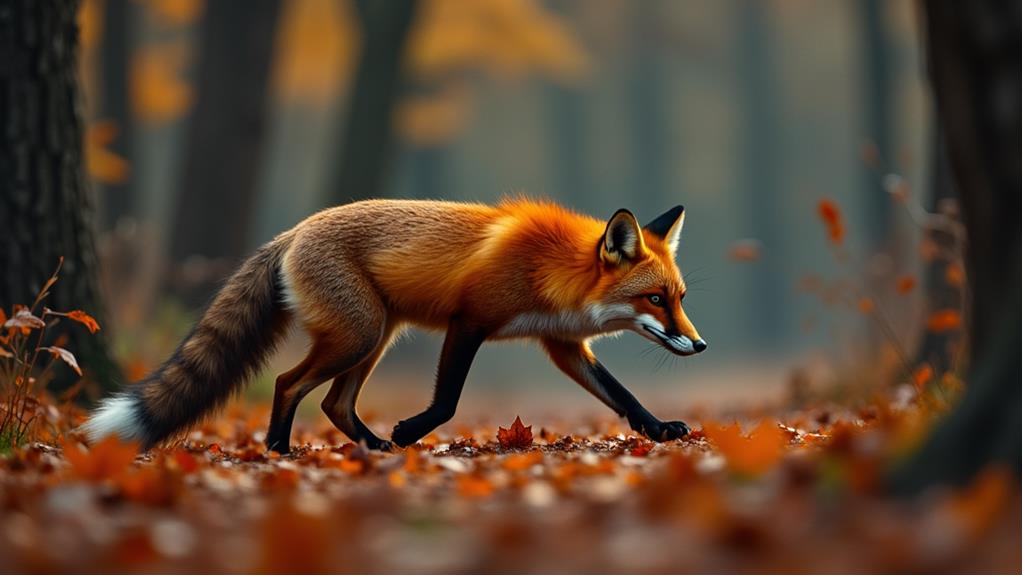
When you think about how foxes hunt, their incredible sense of smell really shines.
Just picture a furry little detective, sniffing out hidden prey with an expertise that's nothing short of amazing. Their ability to detect scents, even in harsh environments, allows them to locate food sources effectively.
They can track animals through dense bushes or underground, relying on their keen noses to tell fresh from stale—talk about a nose for business!
Hunting techniques in the tundra
Scent Discrimination Abilities
How do foxes skillfully navigate their hunting environments? Their incredible scent discrimination abilities are key players in this process.
Imagine how they benefit in the wild by having:
- A highly developed olfactory system that's way more advanced than ours.
- An increased surface area in their nasal turbinates that helps them recognize individual scents.
- A knack for combining smells and sounds to locate food effectively.
- A unique way of sniffing out nearby food sources, even if they're sometimes struggling with buried treasures.
While foxes primarily rely on their sharp hearing, their sense of smell plays a crucial role, too. They can detect scents that help direct them toward potential meals, assisting in their hunt.
However, don't be fooled; they still face challenges when it comes to locating buried food. If they're too far away, those hidden snacks might as well be playing a game of hide and seek!
Understanding these scent discrimination skills not only helps us appreciate these fascinating creatures but also aids in fox control measures. With the right knowledge, we can promote a better coexistence with these clever hunters in our environment.
Tracking Prey Effectively
Foxes are master trackers, and their ability to locate prey relies heavily on their remarkable sense of smell. With an incredible olfactory system, foxes can detect a wide range of scents that help them track down their meals. Imagine having a nose that could pick up faint smells hidden in the environment! That's how these clever hunters pinpoint animals that might be hiding or even buried underground.
They often follow scent trails left by other animals, which leads them right to potential food sources. However, it's funny to note that they might struggle to find a buried snack until they're just about sniffing it out up close!
A fox's unique nose structure, filled with turbinates, enhances their ability to catch even the faintest scent molecules from far away.
Additionally, foxes use scent marking behaviors, like leaving traces of urine or feces, to communicate and track other critters in their territory.
By weaving together scent information and sharp instincts, foxes exhibit incredible skill in tracking prey, making them impressive hunters and essential players in their ecosystems.
Environmental Influences on Smell
Often, the ability to detect scents in their environment hinges on various environmental factors. You're probably curious about how these elements can boost a fox's sense of smell. Here are a few key factors:
- Humidity: Higher humidity helps scent molecules linger longer in the air.
- Temperature: Warmer temperatures can enhance the spread of odors.
- Vegetation: Dense plants provide a rich tapestry of scents, masking some and amplifying others.
- Decomposing Matter: The aroma of decay can lead to a delicious dinner for a hungry fox.
These environmental factors create a multifaceted scent landscape that makes hunting and communicating easier for foxes.
Picture a delicious freshly buried bone, for instance: its scent is much subtler compared to a decaying piece of meat.
Seasonal changes also play a significant role, influencing the types of flora and fauna around.
Foxes are clever creatures, adapting their hunting strategies based on how their surroundings change.
Behavioral Implications of Olfaction
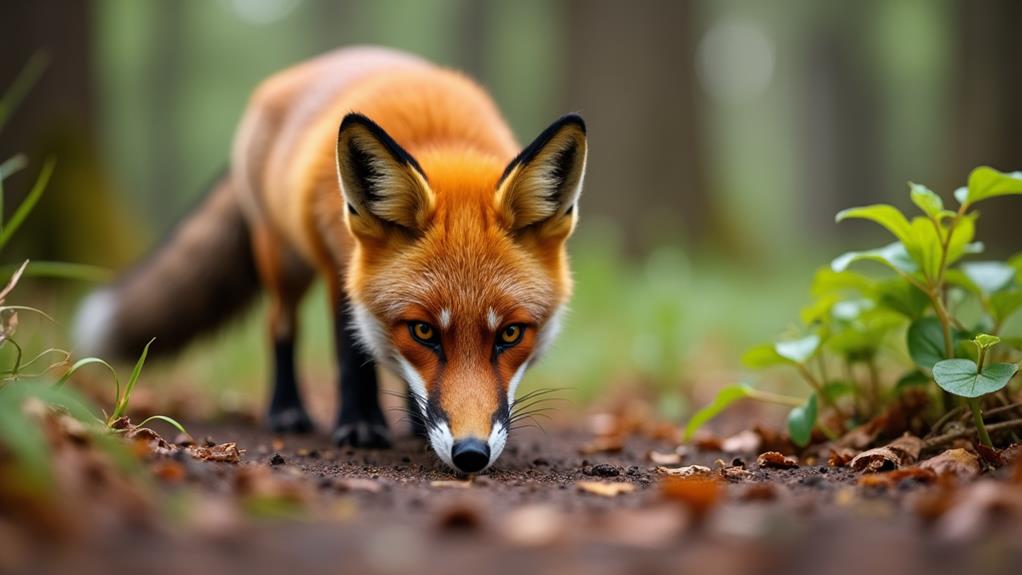
Imagine walking in a forest where every scent tells a story. For foxes, scents are like a secret language, deeply intertwined with their behavior and survival. Their acute sense of smell is central to how they communicate with one another. Whether it's a whiff of food or a hint of a nearby predator, these furry creatures rely on their noses to navigate their world.
Foxes use scent to identify individual peers, and you might say they've mastered "nose-to-nose" communication — only without the fancy words! When they mark their territory with urine, they're laying down a complex map for others to read. It's like posting a "Hello, I'm here!" sign at each corner of their domain.
However, not every sniff is a success story. They sometimes struggle to locate buried food until they're right on top of it, making you wonder if they're just playing a mischievous game.
Final Thoughts
In the wild, a fox's nose is like a superhero's power—able to sniff out danger and dinner alike! Their amazing sense of smell not only fuels their hunting skills but also helps them communicate with others. While we might rely on our eyes to navigate the world, these furry friends teach us that sometimes it's all about what you can't see. So next time you catch a whiff of something delicious, think of the fox and its remarkable nose!

